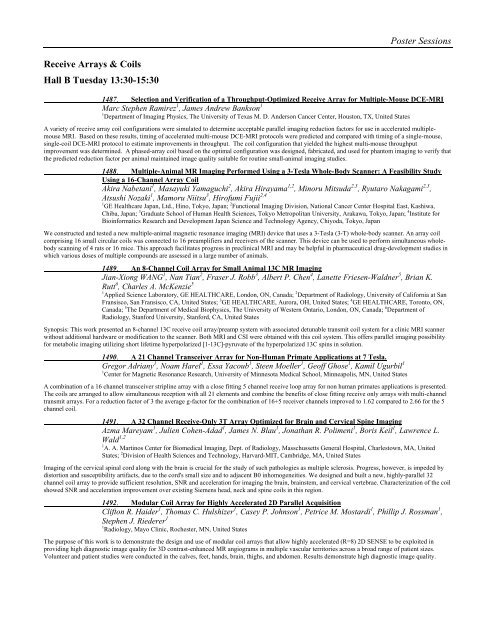TRADITIONAL POSTER - ismrm
TRADITIONAL POSTER - ismrm
TRADITIONAL POSTER - ismrm
You also want an ePaper? Increase the reach of your titles
YUMPU automatically turns print PDFs into web optimized ePapers that Google loves.
Poster Sessions<br />
Receive Arrays & Coils<br />
Hall B Tuesday 13:30-15:30<br />
1487. Selection and Verification of a Throughput-Optimized Receive Array for Multiple-Mouse DCE-MRI<br />
Marc Stephen Ramirez 1 , James Andrew Bankson 1<br />
1 Department of Imaging Physics, The University of Texas M. D. Anderson Cancer Center, Houston, TX, United States<br />
A variety of receive array coil configurations were simulated to determine acceptable parallel imaging reduction factors for use in accelerated multiplemouse<br />
MRI. Based on these results, timing of accelerated multi-mouse DCE-MRI protocols were predicted and compared with timing of a single-mouse,<br />
single-coil DCE-MRI protocol to estimate improvements in throughput. The coil configuration that yielded the highest multi-mouse throughput<br />
improvement was determined. A phased-array coil based on the optimal configuration was designed, fabricated, and used for phantom imaging to verify that<br />
the predicted reduction factor per animal maintained image quality suitable for routine small-animal imaging studies.<br />
1488. Multiple-Animal MR Imaging Performed Using a 3-Tesla Whole-Body Scanner: A Feasibility Study<br />
Using a 16-Channel Array Coil<br />
Akira Nabetani 1 , Masayuki Yamaguchi 2 , Akira Hirayama 1,2 , Minoru Mitsuda 2,3 , Ryutaro Nakagami 2,3 ,<br />
Atsushi Nozaki 1 , Mamoru Niitsu 3 , Hirofumi Fujii 2,4<br />
1 GE Healthcare Japan, Ltd., Hino, Tokyo, Japan; 2 Functional Imaging Division, National Cancer Center Hospital East, Kashiwa,<br />
Chiba, Japan; 3 Graduate School of Human Health Sciences, Tokyo Metropolitan University, Arakawa, Tokyo, Japan; 4 Institute for<br />
Bioinformatics Research and Development Japan Science and Technology Agency, Chiyoda, Tokyo, Japan<br />
We constructed and tested a new multiple-animal magnetic resonance imaging (MRI) device that uses a 3-Tesla (3-T) whole-body scanner. An array coil<br />
comprising 16 small circular coils was connected to 16 preamplifiers and receivers of the scanner. This device can be used to perform simultaneous wholebody<br />
scanning of 4 rats or 16 mice. This approach facilitates progress in preclinical MRI and may be helpful in pharmaceutical drug-development studies in<br />
which various doses of multiple compounds are assessed in a large number of animals.<br />
1489. An 8-Channel Coil Array for Small Animal 13C MR Imaging<br />
Jian-Xiong WANG 1 , Nan Tian 2 , Fraser J. Robb 3 , Albert P. Chen 4 , Lanette Friesen-Waldner 5 , Brian K.<br />
Rutt 6 , Charles A. McKenzie 5<br />
1 Applied Science Laboratory, GE HEALTHCARE, London, ON, Canada; 2 Department of Radiology, University of California at San<br />
Fransisco, San Fransisco, CA, United States; 3 GE HEALTHCARE, Aurora, OH, United States; 4 GE HEALTHCARE, Toronto, ON,<br />
Canada; 5 The Department of Medical Biophysics, The University of Western Ontario, London, ON, Canada; 6 Department of<br />
Radiology, Stanford University, Stanford, CA, United States<br />
Synopsis: This work presented an 8-channel 13C receive coil array/preamp system with associated detunable transmit coil system for a clinic MRI scanner<br />
without additional hardware or modification to the scanner. Both MRI and CSI were obtained with this coil system. This offers parallel imaging possibility<br />
for metabolic imaging utilizing short lifetime hyperpolarized [1-13C]-pyruvate of the hyperpolarized 13C spins in solution.<br />
1490. A 21 Channel Transceiver Array for Non-Human Primate Applications at 7 Tesla.<br />
Gregor Adriany 1 , Noam Harel 1 , Essa Yacoub 1 , Steen Moeller 1 , Geoff Ghose 1 , Kamil Ugurbil 1<br />
1 Center for Magnetic Resonance Research, University of Minnesota Medical School, Minneapolis, MN, United States<br />
A combination of a 16 channel transceiver stripline array with a close fitting 5 channel receive loop array for non human primates applications is presented.<br />
The coils are arranged to allow simultaneous reception with all 21 elements and combine the benefits of close fitting receive only arrays with multi-channel<br />
transmit arrays. For a reduction factor of 3 the average g-factor for the combination of 16+5 receiver channels improved to 1.62 compared to 2.66 for the 5<br />
channel coil.<br />
1491. A 32 Channel Receive-Only 3T Array Optimized for Brain and Cervical Spine Imaging<br />
Azma Mareyam 1 , Julien Cohen-Adad 1 , James N. Blau 1 , Jonathan R. Polimeni 1 , Boris Keil 1 , Lawrence L.<br />
Wald 1,2<br />
1 A. A. Martinos Center for Biomedical Imaging, Dept. of Radiology, Masschussetts General Hospital, Charlestown, MA, United<br />
States; 2 Division of Health Sciences and Technology, Harvard-MIT, Cambridge, MA, United States<br />
Imaging of the cervical spinal cord along with the brain is crucial for the study of such pathologies as multiple sclerosis. Progress, however, is impeded by<br />
distortion and susceptibility artifacts, due to the cord's small size and to adjacent B0 inhomogeneities. We designed and built a new, highly-parallel 32<br />
channel coil array to provide sufficient resolution, SNR and acceleration for imaging the brain, brainstem, and cervical vertebrae. Characterization of the coil<br />
showed SNR and acceleration improvement over existing Siemens head, neck and spine coils in this region.<br />
1492. Modular Coil Array for Highly Accelerated 2D Parallel Acquisition<br />
Clifton R. Haider 1 , Thomas C. Hulshizer 1 , Casey P. Johnson 1 , Petrice M. Mostardi 1 , Phillip J. Rossman 1 ,<br />
Stephen J. Riederer 1<br />
1 Radiology, Mayo Clinic, Rochester, MN, United States<br />
The purpose of this work is to demonstrate the design and use of modular coil arrays that allow highly accelerated (R=8) 2D SENSE to be exploited in<br />
providing high diagnostic image quality for 3D contrast-enhanced MR angiograms in multiple vascular territories across a broad range of patient sizes.<br />
Volunteer and patient studies were conducted in the calves, feet, hands, brain, thighs, and abdomen. Results demonstrate high diagnostic image quality.















